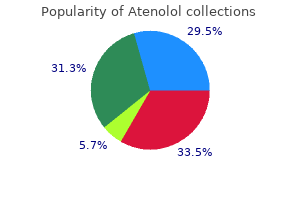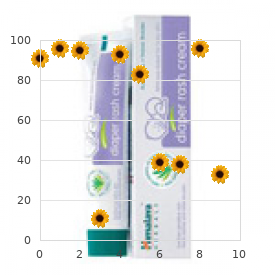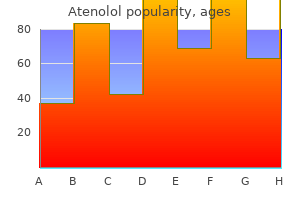CLINICAL,FORENSIC,AND ETHICS CONSULTATION IN MENTAL HEALTH
Atenolol
"Purchase atenolol 100 mg otc, blood pressure 60 over 90".
By: Y. Cobryn, M.B.A., M.B.B.S., M.H.S.
Program Director, Kansas City University of Medicine and Biosciences College of Osteopathic Medicine
In addition to cortical interconnections blood pressure homeostasis proven atenolol 100 mg, there are direct corticofugal projections to the vestibular nuclei arrhythmia exercise purchase cheapest atenolol and atenolol, the parabrachial nuclei pulse pressure facts purchase 50 mg atenolol overnight delivery, and the prepositus hypoglossi hypertensive urgency discount 50 mg atenolol overnight delivery. How these different regions give rise to our perception of motion and spatial orientation is still not understood. Navigation the power to preserve a way of path and to navigate through spatial places is an essential cognitive perform. Studies suggest that an internal mannequin for the spatial representation of our surroundings (cognitive map) exists and is used for navigation. Certain cells in the thalamus, hippocampal region, entorhinal cortex, and subiculum are involved in navigation duties. At least 5 cell types contributing to spatial orientation have been identified, together with place cells, grid cells, head course cells, border cells, and speed cells. Grid cells in the entorhinal cortex respond in a tessellated pattern to spatial location. The Vestibular System 333 these regions have interconnections which are thought to perform collectively to present for spatial orientation, spatial reminiscence, and our ability to navigate to learned places, such as driving to the shop or walking by way of our house in the useless of night. All of these cells depend on a functioning vestibular system to maintain their spatial properties. However, sufferers with disease or trauma to the vestibular system, hippocampus, and dorsal thalamus areas often exhibit extreme deficits in their capability to orient in acquainted environments, to navigate from place to place, or even to find their method house. The resulting elevated density of the cupula produces irregular cupula deflections when the pinnacle adjustments position relative to gravity. Vertigo is an illusion of body motion, usually spinning or turning, experienced when no actual motion is taking place. As children, we all be taught to produce vertigo by whirling in place as fast as possible after which abruptly stopping. Examination of the eyes during this section will reveal a nystagmus that beats within the course reverse to the unique direction of rotation (sometimes referred to as the postrotatory response). Vertigo can additionally be elicited optokinetically if the visible environment are revolved while the physique stays stationary. Many modern amusement games benefit from this phenomenon to produce the feeling of movement. Similar to meningioma, these tumors are slow-growing and patients may current with hearing loss (almost all cases), gait difficulties (about 70% of cases), and tinnitus (about 70% of cases); different signs and signs usually replicate those of elevated intracranial pressure and impingement on the brainstem or cerebellum. When current bilaterally, vestibular schwannomas could additionally be seen in sufferers with neurofibromatosis kind 2. Vestibular Neuritis Benign Paroxysmal Positional Vertigo One of the commonest vestibular issues noticed clinically is benign paroxysmal positional vertigo. This condition is characterized by brief episodes of vertigo that coincide with specific adjustments in body position. In many of these instances, vestibular neuritis is identified and is believed to contain edema of the vestibular nerve (or ganglion). The edema is mostly believed to be produced by way of an acute viral infection, corresponding to herpes simplex virus. In truth, some patients report a current historical past of upper respiratory tract an infection, chilly, or influenza. Treatment choices embody antiemetics, vestibular suppressants, corticosteroids to cut back inflammation, and antiviral agents. Three-dimensional group of vestibular associated eye movements to rotational motion in pigeons. The vestibular finish organs: morphological and physiological diversity of afferents. Sound- and/or pressure-induced vertigo because of bone dehiscence of the superior semicircular canal. Simpson In distinction to olfaction, the taste system displays a restricted vary of sensations. Traditionally, taste sensations have been divided into sweet, salty, bitter, and bitter. In addition to these four basic tastes, a taste sensation termed umami, greatest exemplified by the style of monosodium glutamate, may be important for identification of amino acids.
Common estrogen receptor polymorphism augments effects of hormone replacement therapy on e-selectin however not C-reactive protein hypertension knowledge test cheap 100 mg atenolol with visa. Metabolic and cardiovascular traits: an abundance of lately recognized frequent genetic variants prehypertension treatments and drugs atenolol 50mg with visa. The ubiquitous nature of epistasis in figuring out susceptibility to widespread human diseases blood pressure 40 year old male generic atenolol 100 mg fast delivery. A large-scale genome-wide association examine of Asian populations uncovers genetic components influencing eight quantitative traits blood pressure medication with little side effects buy atenolol canada. Identification of PlCl1 gene for hip bone dimension variation in females in a genome-wide affiliation research. A homologue of the TnF receptor and its ligand enhance T-cell development and dendritic-cell operate. Osteoprotegerin ligand is a cytokine that regulates osteoclast differentiation and activation. TrAnCe (tumor necrosis factor [TnF]-related activation-induced cytokine), a new TnF family member predominantly expressed in T cells, is a dendritic cell-specific survival issue. Osteoclast differentiation factor is a ligand for osteoprotegerin/osteoclastogenesis-inhibitory factor and is equivalent to TrAnCe/rAnkl. Association between lrP5 polymorphism and bone mineral density: a Bayesian meta-analysis. BsmI vitamin d receptor genotypes affect the efficacy of antiresorptive remedies in postmenopausal osteoporotic women. Meta-analysis of the efficacy of hormone substitute therapy in treating and stopping osteoporosis in postmenopausal ladies. Hormone alternative remedy and prevention of nonvertebral fractures: a meta-analysis of randomized trials. Oestrogen-receptor-alpha gene polymorphism affects response in bone mineral density to oestrogen in post-menopausal girls. Association of estrogen receptor alpha gene microsatellite polymorphism with annual modifications in bone mineral density in korean ladies with hormone alternative remedy. Change of bone mass in postmenopausal Caucasian women with and without hormone substitute remedy is associated with vitamin d receptor and estrogen receptor genotypes. Association of vitamin d and estrogen receptor gene polymorphism with the impact of hormone substitute therapy on bone mineral density in Japanese women. The association between heel ultrasound and hormone alternative therapy is modulated by a two-locus vitamin d and estrogen receptor genotype. Association of vitamin d and estrogen receptor gene polymorphism with the consequences of longterm hormone alternative remedy on bone mineral density. Anti-hip fracture efficacy of bisphosphonates: a Bayesian analysis of clinical trials. Vitamin-d-receptor-gene polymorphisms and alter in lumbar-spine bone mineral density. The BsmI vitamin d receptor restriction fragment size polymorphism (bb) influences the impact of calcium intake on bone mineral density. Calcium absorption on high and low calcium intakes in relation to vitamin d receptor genotype. Bisphosphonates are related to increased risk for jaw surgery in medical claims information: is it osteonecrosis Genetic polymorphisms and different risk factors related to bisphosphonate induced osteonecrosis of the jaw. Bisphosphonate-induced osteonecrosis of the jaws, bone markers, and a hypothesized candidate gene. Multiple gene polymorphisms can improve prediction of nonvertebral fracture in postmenopausal women. Prediction of future osteoporotic fracture incidence by genetic profiling: a 6-year follow-up observational study. Here we focus on the various sorts of variants related to genetic disorders, and the kinds of genetic testing out there now and in the future in molecular diagnostic laboratories.

Although relatively rare blood pressure 200110 quality 100 mg atenolol, these lesions may be found anyplace within the central nervous system arrhythmia guidelines 2011 buy atenolol 100 mg line. The facial nerve fibers and intermediate nerve fibers are intermingled throughout the pons but emerge from the brainstem as two separate nerve bundles heart attack or stroke order atenolol on line amex. After exiting the brainstem into the cerebellopontine angle hypertension definition purchase atenolol from india, the facial and intermediate nerves merge and are joined by the vestibulocochlear nerve. Coursing posterolaterally by way of the facial canal within the petrous temporal bone, the facial nerve approaches the middle ear cavity, the place it turns (internal genu) sharply posteriorly and continues superior and posterior to the center ear cavity to eventually exit the temporal bone via the stylomastoid foramen. The greater petrosal nerve programs anteromedially via and on the petrous temporal bone to reach the area simply superior to the foramen lacerum, the place it joins the deep petrosal nerve to kind the nerve of the pterygoid canal. From right here, preganglionic parasympathetic axons enter the pterygopalatine ganglion. Other postganglionic parasympathetic fibers join the maxillary division (V2) of the trigeminal nerve and continue on branches that enter the orbit to provide parasympathetic innervation of the lacrimal gland. The latter nerve enters the middle ear cavity, passes across the inner floor of the tympanic membrane, after which exits the center ear by way of the petrotympanic fissure to reach the infratemporal fossa. Postganglionic fibers from the submandibular ganglion innervate the submandibular and sublingual salivary glands and portions of the mucosal surfaces of the tongue and oral cavity. On exiting the stylomastoid foramen, the fibers of the facial nerve cross by way of and across the parotid gland as the nerve divides into its 5 terminal branches. The central processes of those main afferent fibers continue with the facial nerve, move into the cranial cavity through the inner acoustic meatus, and enter the brainstem in the intermediate nerve. These cell bodies are also located in the geniculate ganglion, and their fibers enter the more caudal parts of the solitary tract and nucleus (cardiorespiratory nucleus). The second variety of sensory fibers within the facial nerve is comparatively small in number. The cutaneous fibers attain their cell our bodies within the geniculate ganglion, and their central processes course into the brainstem with the intermediate nerve. Corticonuclear fibers used within the performance of voluntary actions involving the muscle tissue of facial features distribute to the facial nuclei in a bilateral method. The ipsilateral face motor cortex distributes bilaterally to those facial motor neurons that control muscles in the upper face. In distinction, the face motor cortex project primarily to the contralateral facial motor neurons that control the decrease facial expression muscle tissue, similar to those positioned near the angle of the mouth which are used to smile voluntarily. Lesions of the efferent fibers from the face motor cortex or of the inner capsule (supranuclear) lead to drooping or sagging of the corner of the mouth contralateral to the lesion when the patient is asked to smile voluntarily. Signs and symptoms as a end result of peripheral lesions of the facial nerve (infranuclear, lower motor neuron) rely upon the location of the harm. This motor (the Bell palsy) deficit is accompanied by decreased mucosal secretion in the nasal and oral cavities and decreased tear fluid manufacturing and salivary gland output, all on the ipsilateral side. However, tear fluid production and the mucosal surfaces of the nasal and oral cavities are unaffected because the larger petrosal nerve is unbroken. The afferent limb of this reflex travels via the ophthalmic division of cranial nerve V. The central processes of these fibers have their cell our bodies within the trigeminal ganglion, enter the spinal trigeminal tract, and terminate in the spinal nucleus. Trigeminothalamic fibers originating in the spinal nucleus send collaterals into the facial motor nucleus after which proceed rostrally to the thalamus; this collateral connection completes the reflex circuit. Additional deficits reflecting involvement of the facial nerve are seen in facial diplegia and in hemifacial spasm. Bilateral paralysis of the facial muscle tissue, facial diplegia, may be seen in congenital situations, such as in myotonic muscular dystrophy or within the M�bius syndrome. In this latter syndrome, there are complicated congenital defects that have an effect on actions of the face and eyes (due to partial agenesis of these respective nuclei) and cause defects of the extremities and skeleton. The bilateral facial weak point within the M�bius syndrome incessantly affects the upper portions of the face greater than the lower parts or the entire face. Facial diplegia can additionally be seen in sufferers with Lyme illness (characteristic of the disease), in these with the Guillain-Barr� syndrome (about 50% of fatal instances may have this feature), or in patients who could have botulism poisoning or an infection with Corynebacterium diphtheriae. Hemifacial spasms are irregular and sometimes painful contractions of the facial muscular tissues that may be triggered by voluntary movements of the facial muscular tissues.

Instead arteria doo cheap 100 mg atenolol otc, voluntary control of eye motion is mediated by way of cortical projections from frontal and parietal motor eye fields to eye movement (gaze) control centers within the midbrain and pons hypertension powerpoint presentation cheap atenolol 50mg online. Although the cortex of every hemisphere influences these nuclei bilaterally blood pressure pills names trusted 100 mg atenolol, the resulting eye movements are conjugate and are directed towards the aspect contralateral to the cortex from which the enter originated blood pressure of 90/50 100mg atenolol visa. Within concerning the middle third of the crus, the body is somatotopically arranged, lower extremities most lateral, head-face most medial. From here, these axons descend into the pons and medulla in association with corticospinal fibers. Corticonuclear fibers in the genu and in the crus cerebri receive their blood provide from lenticulostriate arteries and from the paramedian branches of the basilar bifurcation, respectively. Termination Course Corticonuclear axons that originate from cells in layer V of the face motor cortex funnel into the genu of the internal capsule Generally, corticonuclear axons depart the bundle of descending cortical axons barely rostral to the cranial nerve nucleus, where they terminate. The fibers to the trigeminal motor nuclei terminate on interneurons adjoining to the nuclei. The corticonuclear system sends nearly equal numbers of fibers to the left and proper trigeminal motor nuclei. Likewise, practically equal numbers of fibers are despatched to the left and right facial motor nuclei. Whereas the muscular tissues of facial features in the higher half of the face are controlled about equally from both hemispheres, muscles within the decrease half of the face are influenced primarily from the contralateral hemisphere. However, the motor neurons that innervate muscular elements of the taste bud and uvula obtain primarily a contralateral enter. In the case of the hypoglossal nuclei, though corticonuclear fibers normally distribute bilaterally, these motor neurons that innervate the genioglossus muscular tissues obtain primarily contralateral corticonuclear enter. Each genioglossus muscle pulls its half of the tongue anteriorly and slightly medially. When the 2 muscles function together and symmetrically, the tongue protrudes straight out of the mouth. If, nonetheless, the lesion is within the medial medulla and includes the foundation of the hypoglossal nerve, pyramid, and medial lemniscus, the affected person may experience an ipsilateral deviation of the tongue along with a contralateral hemiparesis (corticospinal fiber involvement) and a contralateral lack of posterior column modalities (medial lemniscus involvement). This combination of deficits is an inferior alternating hemiplegia (medial medullary or Dejerine syndrome; Table 25. Hypoglossal root fibers, corticospinal fibers, and the medial lemniscus share a typical blood provide within the medulla fashioned by the anterior spinal artery. These fibers continue into the higher cervical spinal cord together with corticospinal fibers. Clinical observations in sufferers with cortical or inside capsule lesions reveal that the sternocleidomastoid and trapezius muscular tissues (targets of accent motor neurons) are affected primarily on the side ipsilateral to the lesion. This discovering suggests that corticonuclear fibers distribute primarily to the ipsilateral accessory nucleus. Note in A that the uvula deviates towards the facet of the corticonuclear lesion and away from the weak aspect, and the tongue deviates away from the facet of the corticonuclear lesion however towards the weak facet. Removal of a lymph node from the left facet of the neck (A, arrow) inadvertently resulted in damage to peripheral fibers of the hypoglossal nerve on that facet. Increased intracranial strain in a supratentorial compartment forces the uncus over the edge of the tentorium and into the midbrain, damaging the oculomotor nerve and the crus cerebri on that facet. In sufferers with corticospinal indicators accompanied by cranial nerve signs on the other side of the body, two essential facts come to mind. Second, the cranial nerve deficit is one of the best localizing sign as a end result of it offers, together with a long tract deficit (corticospinal in this example), probably the most precise location and level of the lesion. Having made this distinction concerning the localizing signal, you will want to notice that there are examples of what are referred to as false localizing signs. One instance of that is the Kernohan syndrome (also called the Kernohan notch phenomenon). In this example (ipsilateral oculomotor paralysis plus ipsilateral hemiplegia), the hemiplegia is the false localizing signal. The combination of oculomotor and corticospinal deficits suggests that uncal herniation may be the underlying trigger of those symptoms. The Kernohan syndrome illustrates an necessary general concept regarding posterior fossa lesions that will affect the brainstem. Because the rubrospinal system primarily influences flexor musculature, this pathway could complement the perform of the corticospinal tract.
Purchase atenolol on line amex. Автоматический тонометр на запястье OLIECO / Automatic blood pressure monitor OLIECO.

